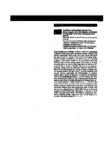Use este identificador para citar ou linkar para este item:
http://www.alice.cnptia.embrapa.br/alice/handle/doc/16157| Título: | Identification of endophytic bactéria from micropropagated yacon (Smallanthus sonchifolius) crowing under autotrophic and Heterotrophic systems. |
| Autoria: | MORAES, R. M.  MELO, I. S. de   JOSHI, V. C.   SUMYANTO, J.   SAMOYLENKO, V.   ILIAS, M.   |
| Afiliação: | R. M. Moraes, University of Mississippi; ITAMAR SOARES DE MELO, CNPMA; V. C. Joshi, University of Mississippi; J. Sumyanto, University of Mississippi; V. Samoylenko, University of Mississippi; M. Ilias, University of Mississippi. |
| Ano de publicação: | 2008 |
| Referência: | In: Planta Médica, Dordrecht, v.74, n.3, p.323, 2008. Abstracts of the 7 th Annual Oxford International Conference on the Science of Botanicals & American Society of Pharmacognosy 4th Interim Meeting, Oxford, MS, 2008. |
| Conteúdo: | Yacon, Smallanthus sonchifolius, an Andean species. is a rich source of dictetíc oligofructans with low glucose content. proteins and phenolic compounds. These constituents have shown efficacy in the prevention of diet-related ehronic diseases, including gastroin-testinal disorders and diabetes |1,2|. Yacon is part of a research program at the National Center for Natural Products Research (NCNPR) and University of Mississippi Field Station to develop new alternative root crops for Mississippi while attempting to im-prove the diet of low incorne families. Yacon can be easily propa-gated by cultings. Virus and nematode infections have been re-ported on plants propagated by cuttings in Brazil. a country that hás adopted Yacon as specialty crop [3|. We have developed two culture systems. autotrophic and heterotrophic, to produce healthy plants. Herem we describe the presence of endophytic bactéria m micropropagated Yacon. In auxin free media, new roots were induced. Overa 15day period. the average root mduction per expiam was 5.45 to 8.75 under autotrophic and heterotrophic cul-tures, respectively. Root lenglh vaned between 3 and 60mrn. The presence of root hairs and lateral roots was noticed only in auto-trophic condilions. These beneficiai bactéria were identified and chemically ctiaracterized. Acknowledgement: This research work was partially supported by the USDA/ARS Cooperative Research Agreement No. 58-6408-2-009. Referentes; |1) Terada S. et ai. (2006] Yakugaku Zasshi 126(8): 665-669. (2| Valentová K. Ulri-chová j. (2003) Biomedical Papers 147: 119-130. [3| Mogor C. et ai, (2003) Acta Horticulturea 597: 311 -313. |
| Thesagro: | Bactéria |
| Palavras-chave: | Identification Endophytic Micropropagated Autotrophic Heterotrophic systems |
| Tipo do material: | Resumo em anais e proceedings |
| Acesso: | openAccess |
| Aparece nas coleções: | Resumo em anais de congresso (CNPMA)  |
Arquivos associados a este item:
| Arquivo | Descrição | Tamanho | Formato | |
|---|---|---|---|---|
| 2008RA020.pdf | 46,89 kB | Adobe PDF |  Visualizar/Abrir |









